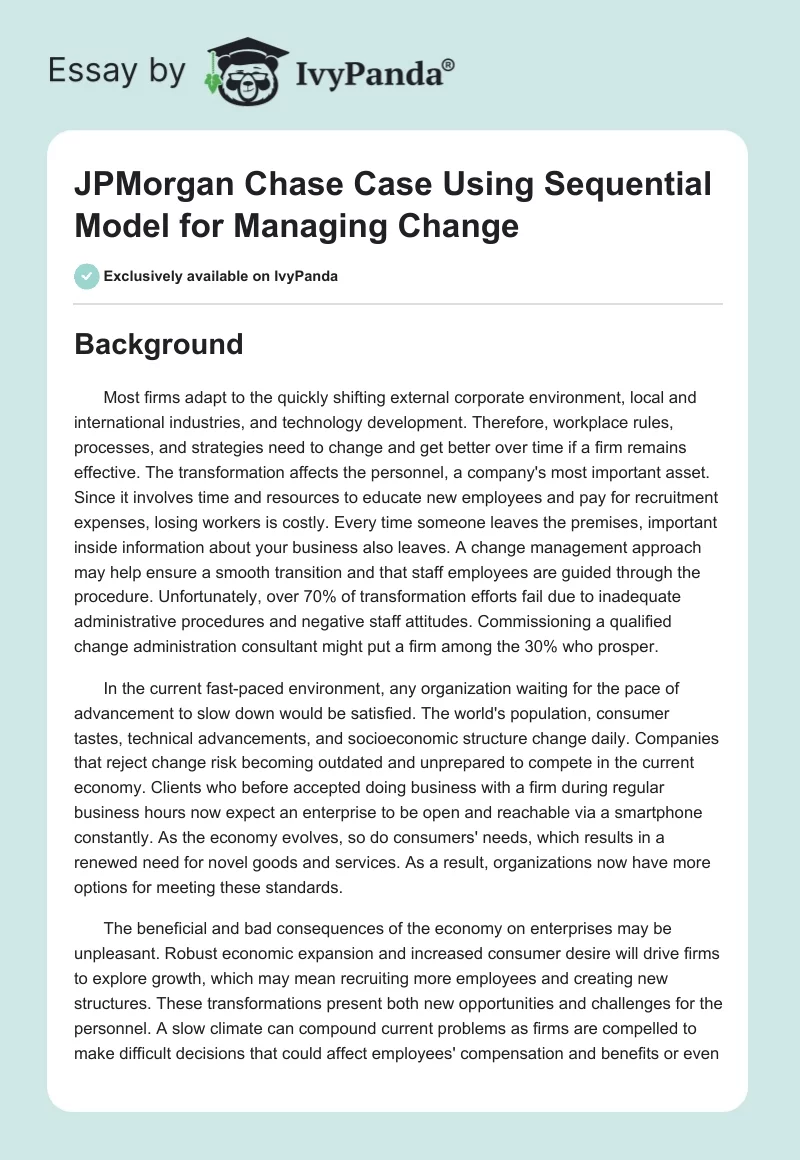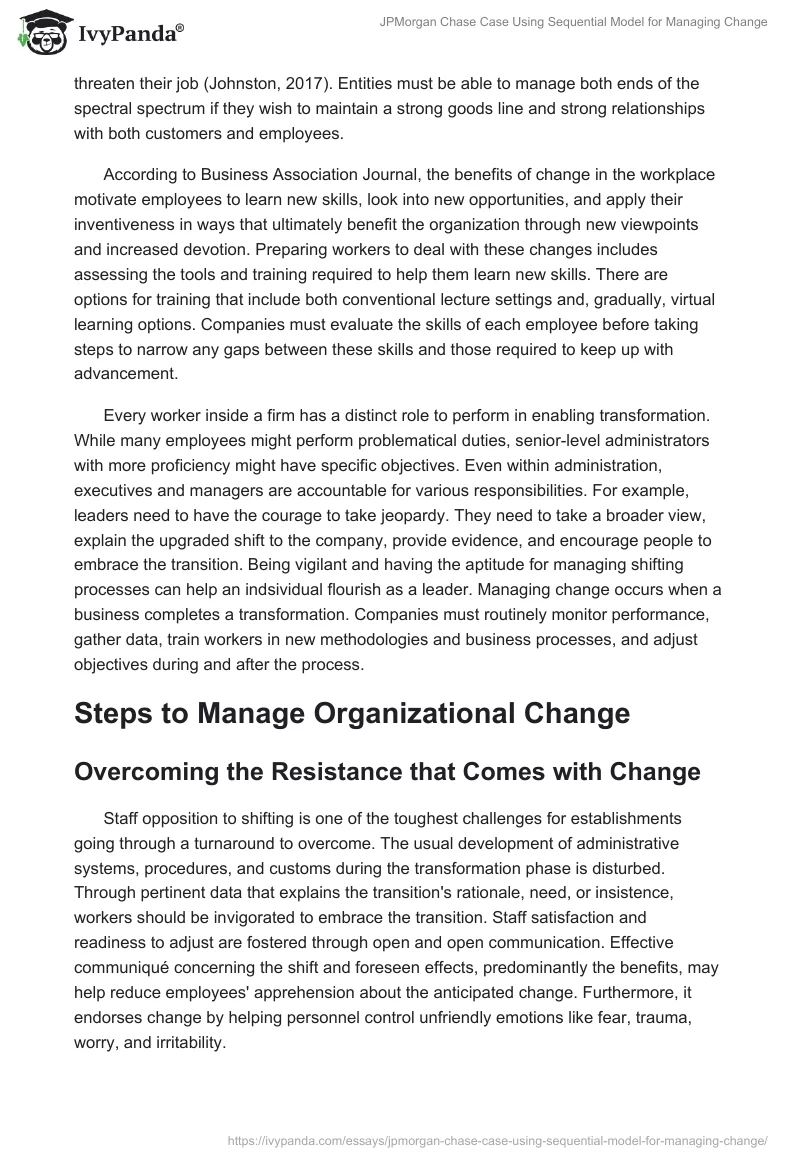Background
Most firms adapt to the quickly shifting external corporate environment, local and international industries, and technology development. Therefore, workplace rules, processes, and strategies need to change and get better over time if a firm remains effective. The transformation affects the personnel, a company’s most important asset. Since it involves time and resources to educate new employees and pay for recruitment expenses, losing workers is costly. Every time someone leaves the premises, important inside information about your business also leaves. A change management approach may help ensure a smooth transition and that staff employees are guided through the procedure. Unfortunately, over 70% of transformation efforts fail due to inadequate administrative procedures and negative staff attitudes. Commissioning a qualified change administration consultant might put a firm among the 30% who prosper.
In the current fast-paced environment, any organization waiting for the pace of advancement to slow down would be satisfied. The world’s population, consumer tastes, technical advancements, and socioeconomic structure change daily. Companies that reject change risk becoming outdated and unprepared to compete in the current economy. Clients who before accepted doing business with a firm during regular business hours now expect an enterprise to be open and reachable via a smartphone constantly. As the economy evolves, so do consumers’ needs, which results in a renewed need for novel goods and services. As a result, organizations now have more options for meeting these standards.
The beneficial and bad consequences of the economy on enterprises may be unpleasant. Robust economic expansion and increased consumer desire will drive firms to explore growth, which may mean recruiting more employees and creating new structures. These transformations present both new opportunities and challenges for the personnel. A slow climate can compound current problems as firms are compelled to make difficult decisions that could affect employees’ compensation and benefits or even threaten their job (Johnston, 2017). Entities must be able to manage both ends of the spectral spectrum if they wish to maintain a strong goods line and strong relationships with both customers and employees.
According to Business Association Journal, the benefits of change in the workplace motivate employees to learn new skills, look into new opportunities, and apply their inventiveness in ways that ultimately benefit the organization through new viewpoints and increased devotion. Preparing workers to deal with these changes includes assessing the tools and training required to help them learn new skills. There are options for training that include both conventional lecture settings and, gradually, virtual learning options. Companies must evaluate the skills of each employee before taking steps to narrow any gaps between these skills and those required to keep up with advancement.
Every worker inside a firm has a distinct role to perform in enabling transformation. While many employees might perform problematical duties, senior-level administrators with more proficiency might have specific objectives. Even within administration, executives and managers are accountable for various responsibilities. For example, leaders need to have the courage to take jeopardy. They need to take a broader view, explain the upgraded shift to the company, provide evidence, and encourage people to embrace the transition. Being vigilant and having the aptitude for managing shifting processes can help an indsividual flourish as a leader. Managing change occurs when a business completes a transformation. Companies must routinely monitor performance, gather data, train workers in new methodologies and business processes, and adjust objectives during and after the process.
Steps to Manage Organizational Change
Overcoming the Resistance that Comes with Change
Staff opposition to shifting is one of the toughest challenges for establishments going through a turnaround to overcome. The usual development of administrative systems, procedures, and customs during the transformation phase is disturbed. Through pertinent data that explains the transition’s rationale, need, or insistence, workers should be invigorated to embrace the transition. Staff satisfaction and readiness to adjust are fostered through open and open communication. Effective communiqué concerning the shift and foreseen effects, predominantly the benefits, may help reduce employees’ apprehension about the anticipated change. Furthermore, it endorses change by helping personnel control unfriendly emotions like fear, trauma, worry, and irritability.
Including the Employee in the Decision-Making Process
Employee absence from the transitioning process typically contributes to their discontent with systemic change. However, if employees are involved in the reform endeavor, they will feel more in control of the outputs. Giving employees a small amount of empowerment affects their feelings because it gives them a sensation of control over the shifting process and helps the change drive. According to this viewpoint, effective upward connection offers staff a sense of ownership and involvement, which enhances employee collaboration and adoption of the change while also allowing management to hear from the workforce.
Building Mutual Interpretation and Shared Understanding
Implementing a change project produces a new experience through information sharing. When faced with a change project, workers instantly attempt to grasp it and its possible implications on them. This sensing process may resolve misunderstandings and uncertainties when supported by proper institutional knowledge and interaction. However, individuals inside an organization frequently come from a variety of origins; have varying interests, perspectives, positions, levels of training, etc. They could interpret the same circumstance in diverse ways. According to research, people’s reactions and reactions to change can interact and have an impact on one another over a period.
Therefore, developing common knowledge and translation between leadership and workers, as well as between workers and employers, is dependent upon successful communication and interaction. For example, companies might develop a picture of the change’s purpose, need, and implementation strategy. To enlighten, foster comprehension, and alter the thoughts and conduct of workers during the re-orientation stage, imaginative dialogue must be performed professionally. This may involve several factors, including interaction time, message, channels, and origin. When firms prioritize significant, transparent, and regular information, staff may more easily understand the reason for the transition. This focused communication method provides the background needed to get the changes. Efficient communication provides an answer to the most crucial query that individuals have.
JP Morgan Chase in Cross-Selling Case
Cross-selling encourages users of one product, such as banking, to use another, such as investments or debit cards. Chase bank declared in 2016 that it needed to conduct more cross-selling. Cross-selling was specifically encouraged by JPMorgan Chase by having its workers inform consumers about other goods and solutions. JPMorgan used the time-tested tactic of rewarding successful cross-selling workers to persuade them to endorse the project. Nothing went awry here, so. Employees reportedly opened fictitious profiles in the identities of current JPMorgan Chase clients in addition to cross-selling in response to these offers. JPMorgan committed various errors, including failing to openly acknowledge the issue quickly enough and lacking sufficient safeguards to find the phony identities. But what makes this issue special is how many staff members were complicit in the misconduct. Unlike many others, this business crisis was not caused by one or two bad CEOs in a generally stable firm. This was just outright wrongdoing on a grand scale.
Many methods could be used to manage the cross-selling case at JP Morgan’s Chase. But one of the best methods includes the sequential method of change implementation. The sequential method involves a step-by-step introduction to change to the organization’s stakeholders, such as the owners and the employees. The method ensures that the process does not ambush the employees; they are key decision-makers in the whole process. This is important since the employer’s and the employee’s views would be incorporated into the system, which could help produce a favorable change system for all. The following steps could be used to make the change process at JP Morgan more fruitful.
Designing New Strategically Aligned Behavior
Designing new strategically aligned behavior helps the change participants know their roles, positions, and responsibilities. Chase bank would have been clear to the employees and the stakeholders on their objectives and what they wish to achieve. This would have helped every organization member to know their role in the procedure and the possible outcomes in case of alteration from the main agenda. Although it may seem apparent, many companies need to take this early, important step. Finance and ethics are one thing to direct the essential change to ensure that the transformation can move a corporation on the correct path. This stage can also help firms to calculate the transformation’s value, which quantifies the time and resources they should devote to it.
Training, Mentoring, and Coaching before and during the procedure
Chase Bank might offer coaching, mentorship, and education to achieve greater results. The company may hire change management specialists who would educate the staff on the value of the transition for both the company and themselves. The personnel would have had the essential abilities to make the adjustment necessary. Therefore this could have become crucial. Individuals may benefit greatly from professional executive training in their private and corporate lives. The advantages can be felt right away, but they also last over time, from work to locus, throughout a profession, and a person’s life. Only some organizational perks or education schemes can make that statement—one significant teaching method benefits individuals by allowing them to distinguish themselves more openly. A trainer gives you the opportunity and outline to replicate, which is indispensable for education and expansion. They help recognize the morals and the capacities in which the activities depart from the declared objectives or moral principles.
People Alignment
The third step includes sorting employees where every employee could move to the sector they are comfortable with. The alignment of the employees may include assessment, replacement of unfit employees, promotion, and recruitment of new staff. Assessing the employees of Chase Bank before initiating the change process could have the corporation know which set of individuals are suitable for given positions. Assessing the employees could have exposed gaps in the system, creating the need to replace some employees who would not be suitable for the change. More experienced individuals would have been recruited into the team to cover the gaps left by the replaced individuals. This would force the organizations to give promotions to more qualified employees. The process of employee alignment could have been expensive to implement but worth it in the long run.
Systems and Structures
The evaluation of the effects of the adjustments on the company is part of the change effort project’s last stage. Evaluations are conducted for reporting arrangements, pay, and results from the assessment. Regarding an administrative structure, reporting relations means that every employee is given a position on an organization’s hierarchy. According to the organizational hierarchy, the employees answer to the person above them. Employees must dedicate time to the transition procedure to make it go smoothly. JP Morgan Chase Bank could have been smart to pay the staff members who had made the procedure possible.
They could have felt more confident and thought the adjustment was worthwhile. The final element in JP Morgan’s change management program would be measuring and evaluating the outcomes of the recently launched change. This aided the business in spotting system flaws sooner before they could have led to more catastrophic problems. The company might have decided to continue with the initiative by measuring performance and results.
References
Johnston, K. (2017). 2017/42 ASDA retail employees can compare themselves to distribution center employees in equal pay claim (UK). European Employment Law Cases, 2(4), 198–200. Web.


